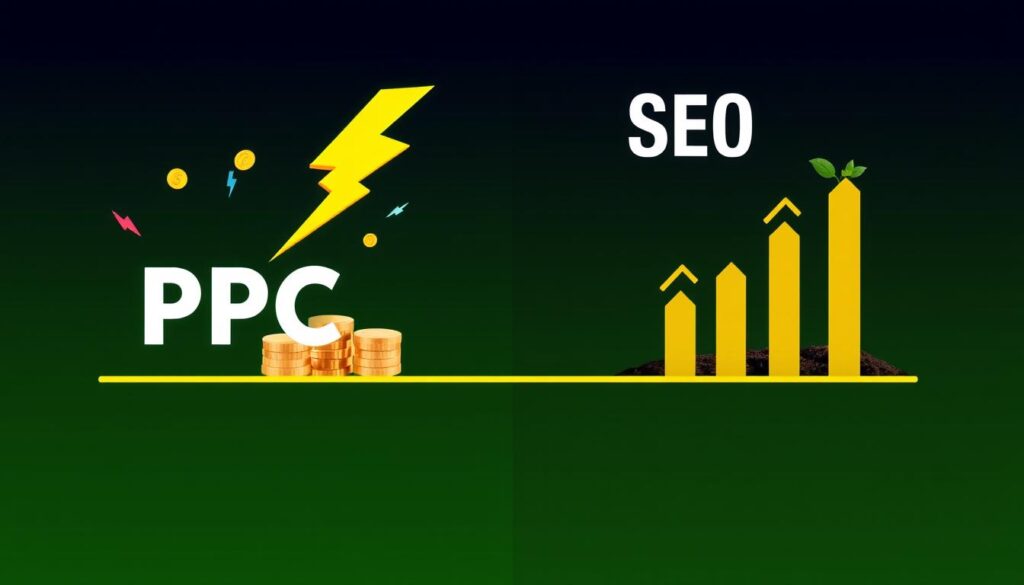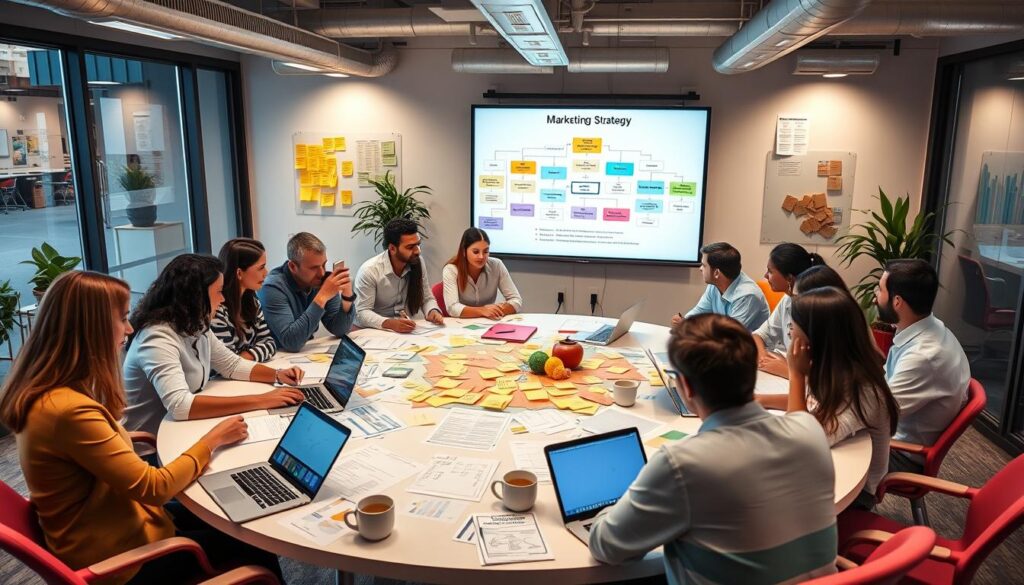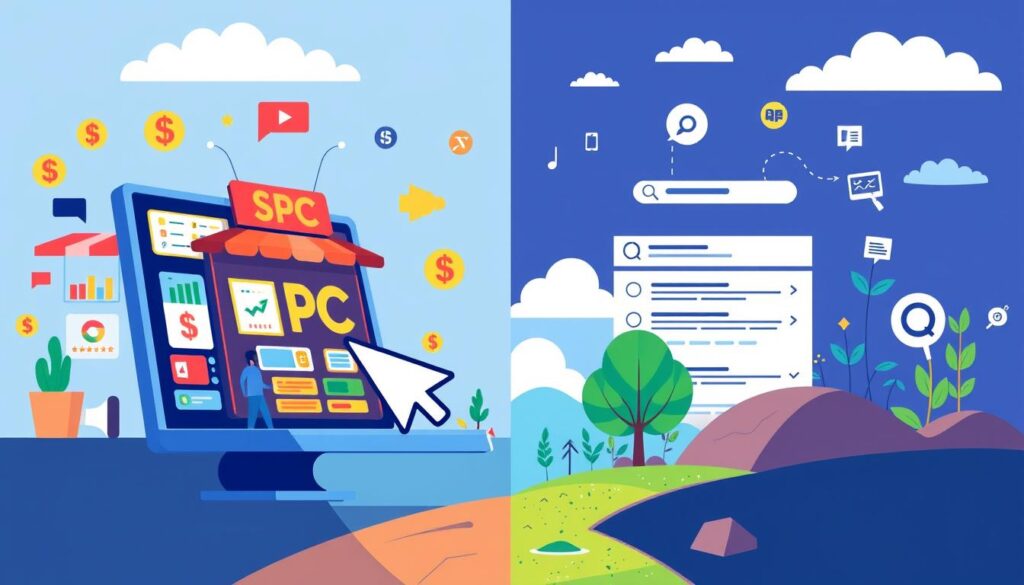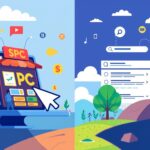For any business owner looking to scale your business, you’ve got two main ways to bring in customers through Google – PPC advertising and SEO. PPC puts your business right at the top of search results with an ad. It’s direct and measurable – you only pay when someone clicks. Many of our local clients in Bergen County and Princeton use this to drive immediate sales and leads.
SEO is your long-term strategy. It gets your website showing up naturally in search results without paying for ads. While it takes more time than PPC, we’ve seen great success with businesses from Montclair to Atlantic City using SEO to build lasting online visibility that brings in customers month after month.
Your choice between PPC and SEO depends on what your business needs right now. Are you looking for quick results to promote a new service? Or are you building for sustained growth?
Did you know search engines change their rules a lot? This means the digital world is always shifting. For your business, picking the right path is key. You have two big choices: Pay-Per-Click (PPC) ads and Search Engine Optimization (SEO).
PPC ads show up right away at the top of search results. You only pay when someone clicks on your ad. This way, you control your budget and reach the right people.
SEO, on the other hand, helps your site show up in search results without ads. It takes a bit longer, but it can keep bringing in visitors for a long time. This is a smart way to save money in the long run.
Deciding between PPC and SEO depends on what you want to achieve and how fast you need it. Knowing what each can do is important. It helps you make a plan that grows your business and saves money.
Key Takeaways
- PPC offers immediate visibility and targeted reach
- SEO provides long-term, cost-effective organic traffic
- Algorithm updates significantly impact both strategies
- SEO typically takes 4-12 months for notable results
- Combining PPC and SEO can maximize marketing impact
- Strategy choice depends on business goals and resources
Understanding Search Engine Marketing Fundamentals
The digital world has changed a lot. Now, SEO and PPC are key for businesses. They help get more people to see your site.
What is Search Engine Optimization (SEO)?
SEO makes your site show up better in search results. It’s about making your site better for search engines. It takes about two years to get to the top of Google.
What is Pay-Per-Click (PPC) Advertising?
PPC means you pay for each ad click. It gives quick results and lets you target exactly who sees your ads. You can start seeing results right away.
The Digital Marketing Landscape Today
Today, businesses use both SEO and PPC. They pick based on their budget, how fast they need results, and their industry.
| Aspect | SEO | PPC |
|---|---|---|
| Timeline | Long-term (avg. 2 years for first page) | Immediate results |
| Cost Structure | Initial investment, ongoing maintenance | Pay per click (varies from one industry to another) |
| Traffic Consistency | Consistent after achieving rankings | Stops when ad spending stops |
With 15.2% of retail sales online in Q2 2024, knowing SEO and PPC is key. Your choice depends on your goals, resources, and who you want to reach.
The Power of Search Engine Optimization
Search Engine Optimization (SEO) helps websites grow by getting more organic traffic. It makes sites more visible in search results. SEO has four key parts: keyword research, on-page SEO, off-page SEO, and technical SEO.
Improving these areas helps sites rank better and attract more visitors. This means more people can find your website.
Creating great content is key to SEO success. Your content should meet user needs and be high-quality. This way, your site ranks higher in search results.
Good content also makes users happy. This builds trust and credibility with your audience.
Getting backlinks from other sites is also important. Backlinks show search engines your content is valuable. This can really help your site rank better and get more visitors.
SEO is a smart choice because it’s cost-effective over time. But, it takes time and effort. It can take 4-12 months to see results, especially for hard-to-rank keywords.
But the rewards are worth it. A study showed a university in Louisiana got 159% more organic traffic with SEO. They used SEO with other marketing strategies.
To do well in SEO, you must keep up with changes and best practices. Staying current helps your site rank better and grow over time.
Pay-Per-Click Marketing Essentials
Pay-per-click (PPC) marketing is a strong tool in digital ads. It lets businesses get more site visits with paid search ads. Sites like Google Ads give quick visibility and target ads well.
How PPC Campaigns Work
PPC campaigns use a cost per click model. Advertisers bid on keywords that fit their business. When users search for these terms, ads show up in results. Advertisers only pay when someone clicks on their ad.
Key Components of Successful PPC
Good PPC campaigns need a few key things:
- Keyword research focused on commercial intent
- Strategic keyword bidding
- Precise ad targeting
- Compelling ad creation
- Ongoing budget management
Google Ads and Other PPC Platforms
Google Ads is the top PPC choice, with 92.47% market share. Other big names include:
| Platform | Average CPC |
|---|---|
| Google Ads (Search) | $2.69 |
| LinkedIn Ads | $5.39 |
| Amazon | $0.97 |
| YouTube | $1.50 |
| TikTok Ads | $1.00 |
| Facebook Ads | $0.94 |
PPC gives clear results and fast visibility. It needs constant care to stay effective and keep costs down. With the right plan, businesses can use PPC to get more targeted traffic and increase sales.
PPC vs SEO: Key Differences and Comparisons
SEO and PPC are two ways to market on search engines. SEO helps grow organic traffic. PPC uses ads to get paid traffic.
Choosing between SEO and PPC depends on your goals. SEO costs $1,500 to $5,000 a month. It grows over time. PPC costs $100 to $10,000 a month. It gives quick results but costs more.
SEO attracts users who really want your content. PPC is great for new products or rebranding. Many businesses use both for the best results.
| Aspect | SEO | PPC |
|---|---|---|
| Timeline | Long-term results | Immediate visibility |
| Cost Structure | Initial investment, lower long-term costs | Ongoing ad spend |
| Traffic Type | Organic | Paid |
| Conversion Rates | Builds over time | Immediate, highly targeted |
| Flexibility | Less flexible, algorithm-dependent | Highly adaptable, quick changes possible |
In 2024, SEO is still key. It focuses on quality content and user experience. PPC is very flexible, allowing fast changes. Your choice depends on your goals, budget, and time frame. Many use both for a strong digital marketing plan.
Cost Considerations: Investment vs. Return
When planning your marketing budget, it’s crucial to weigh the costs and potential returns of SEO investment against PPC campaigns. Both strategies offer unique advantages, but their financial implications differ significantly.
SEO Budget Planning
SEO requires an upfront investment in content creation and optimization. While initial costs may seem high, the long-term value of SEO is undeniable. With 53.3% of website traffic coming from organic search, a well-executed SEO strategy can drive substantial traffic without ongoing per-click costs.
PPC Campaign Costs
PPC campaigns operate on a cost per click model, making budgeting more straightforward but potentially more expensive over time. The advantage? PPC traffic converts 50% better than organic traffic, offering quicker returns. However, 46% of clicks go to the top three ads, highlighting the importance of competitive bidding.
Long-term ROI Analysis
Analyzing long-term ROI is key to making informed decisions. SEO typically shows a minimum ROI of 500% over time, with peak results often seen in the second or third year. In contrast, PPC ROI can be more immediate but requires constant budget management.
| Factor | SEO | PPC |
|---|---|---|
| Initial Cost | Higher | Lower |
| Ongoing Costs | Lower | Higher |
| Time to Results | Months | Days |
| Long-term Value | High | Moderate |
Ultimately, the choice between SEO and PPC depends on your business goals, timeline, and available resources. Many successful digital marketing strategies incorporate both to maximize reach and ROI.
Timeline and Results Speed
PPC and SEO have different times for seeing results. PPC ads show up fast, taking websites to the top of search results right away. This is great for quick wins and fast campaigns.
SEO, however, is a slow but steady plan. It needs time and effort to really show off. SEO helps websites get more visitors over time. It might take a few weeks for small wins, but big results come after months of work.

PPC and SEO work in different ways. PPC ads give quick, clear results right away. SEO, though, builds up slowly, with the best results often coming after a year or two.
| Metric | PPC | SEO |
|---|---|---|
| Initial Results | Immediate | 1-2 weeks (low-competition keywords) |
| Significant Impact | Days to weeks | 6-12 months |
| Peak Performance | Ongoing with active campaigns | 2-3 years |
| Traffic Growth | Immediate, tied to ad spend | Gradual, compounding over time |
| Campaign Duration | Short-term to ongoing | Long-term strategy |
Deciding between PPC and SEO depends on your goals. PPC is for fast results, while SEO builds a strong online presence over time.
Measuring Success and Performance Metrics
It’s key to track the right metrics to see how well your digital marketing works. SEO and PPC both use analytics to check their success. This helps them get better over time.
SEO Key Performance Indicators
SEO success is shown by many KPIs. Things like organic search rankings and traffic volume are important. Also, how many clicks you get and how many turn into sales matter a lot.
Improving these areas is what SEO performance optimization is all about. It aims to make these numbers better over time.
PPC Analytics and Tracking
PPC gives you quick and clear data. You can see how many clicks you get, how much each click costs, and how much money you make from ads. Quality score is also key for PPC success.
These numbers help you make your paid ads better. They give you insights to improve your strategy.
Conversion Rate Optimization
Both SEO and PPC can get better with conversion rate optimization. This means looking at how users act and making your site or landing pages better based on that.
By making your site better, you can make your marketing more effective. This is true for both organic and paid traffic.
| Metric | SEO | PPC |
|---|---|---|
| Traffic Source | Organic Search | Paid Ads |
| Time to Results | Months | Immediate |
| Cost Structure | Initial Investment | Ongoing Costs |
| Key Metrics | Rankings, Organic Traffic | CTR, CPC, ROAS |
Using these metrics and analytics tools helps businesses improve their SEO and PPC. This way, they can get the most out of their marketing. It helps them make smart choices about where to spend their money.
Business Size and Industry Considerations
Choosing between SEO and PPC depends on your business size and industry. Let’s look at how these factors affect marketing choices.
Small Business Solutions
Small businesses can use local SEO and targeted PPC. They have small budgets but can still compete well. Local SEO makes them seen in certain areas. Targeted PPC lets them reach the right people.
Enterprise-Level Strategies
Big businesses use enterprise SEO and PPC. They do lots of SEO and PPC to reach more people. They use their big resources to win in search results.
Industry-Specific Approaches
PPC and SEO vary by industry. For example, B2B companies use LinkedIn for PPC. E-commerce sites focus on Google Shopping ads. It’s key to match your strategy to your industry.
| Business Size | SEO Focus | PPC Focus |
|---|---|---|
| Small Business | Local SEO, Niche Keywords | Targeted Campaigns, Low-Competition Keywords |
| Enterprise | Comprehensive Site Optimization, Link Building | Multi-Channel Campaigns, Brand Protection |
| Industry-Specific | Sector-Relevant Content, Technical SEO | Platform Selection, Industry-Specific Ad Copy |
Deciding between SEO and PPC depends on your industry and resources. By matching your strategy to your business, you can grow and succeed.
Combining SEO and PPC for Maximum Impact
A strong marketing plan uses SEO and PPC together. This mix boosts digital marketing. It makes your online presence stronger and gets better results.
SEO helps you show up in search results over time. PPC gives you quick visibility. Using PPC data for SEO can make your search performance better.
Using data to improve your strategy is important. Google Ads tools can make your landing pages better. This helps both paid and organic traffic.
A/B testing in PPC can find the best messages. These messages can make more people click on your ads. This is true for both paid and organic ads.
| Benefit | SEO | PPC |
|---|---|---|
| Traffic Source | 68% (combined with PPC) | 68% (combined with SEO) |
| Time to Results | Months to a year | Immediate |
| Cost Efficiency | Lower long-term cost | Immediate visibility |
| Data Collection | Slower, but comprehensive | Quick insights for strategy |
Matching your organic pages with paid keywords is smart. It makes your message clear and powerful. This mix of SEO and PPC makes your digital marketing strong. It helps you get a better return on investment and improves your search performance.
Marketing Strategy Implementation Tips
Good marketing mixes SEO and PPC for the best results. Here are some tips for doing it well.
Creating an Effective Marketing Plan
Creating a marketing plan is key. First, set clear goals and know who you’re talking to. Use both SEO and PPC to reach more people.
SEO takes time, but PPC gets you seen right away. Most people skip ads, but PPC puts you at the top.

Resource Allocation
Managing resources well is important. Spend money based on what you need now and later. PPC costs money all the time, but SEO is cheaper in the long run.
SEO brings free visitors, which is a big plus. Mix what you need now with what will grow later for the best results.
Team Structure and Management
Working together is crucial. Make teams that work well together, like SEO and PPC. Share knowledge and plan together.
Check how you’re doing often. Use things like website visits and ad rankings to see how you’re doing. This helps you work better together and meet your goals.
| Strategy | Time to Results | Cost Effectiveness | User Trust |
|---|---|---|---|
| SEO | Weeks to months | High | Higher |
| PPC | Immediate | Varies | Lower |
Conclusion
Choosing between SEO and PPC is key for any online marketing plan. SEO brings in 53% of website visits, giving lasting results. It builds trust and has a good return on investment, but it takes time.
PPC, however, gives quick visibility and targets well. It gets 27% of website visits and has a 35% chance of sales. This makes it great for fast results and for those who can keep spending.
But, you don’t have to pick just one. Many use both, spending about 75% on SEO and 25% on PPC. This way, you get the best of both worlds, helping your business grow steadily.
What works best for you depends on your goals, budget, and what you do. Keeping an eye on how things are going and making changes is crucial. This way, you can make your online marketing strong and help your business grow.



